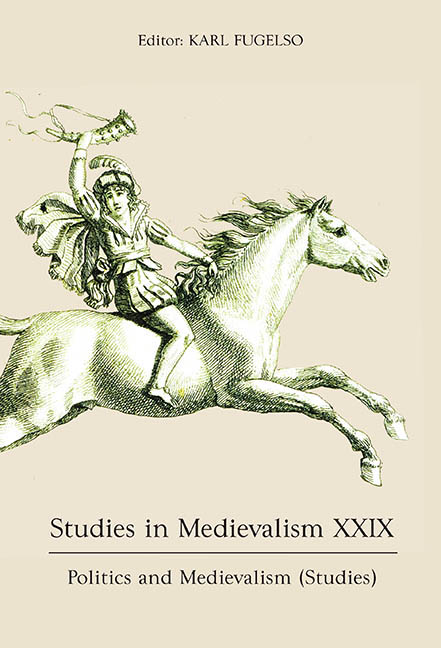Book contents
- Frontmatter
- Studies in Medievalism
- Acknowledgments
- Contents
- List of Illustrations
- Preface
- I Essays on Politics and Medievalism (Studies)
- Historical Malapropism and the Medieval Blood Libel in American Politics
- Putin’s Medieval Weapons in the War against Ukraine
- The Battle of Tours and the US Southern Border
- Medievalism, Brexit, and the Myth of Nations
- An Arthur for the Brexit Era: Joe Cornish’s The Kid Who Would be King
- II Other Responses to Medievalism
- Angle-ing for Arthur: Erasing the Welsh in Guy Ritchie’s King Arthur: Legend of the Sword
- Chasing Freyja: Rape, Immigration, and the Medieval in Alt-Right Discourse
- “Things painted on the coarse canvas”: Political Polemic in Jean-Paul Laurens’s Portrait of the Child Emperor Honorius
- Longfellow and Old English
- Archaeology and Medievalism at Julian of Norwich’s Anchorite Cell
- A Revelation of Love: Christianity, Julian of Norwich, and Medieval Pity in the Harry Potter Series
- In the Beginning Was the Word: How Medieval Text Became Fantasy Maps
- Objectivity, Impossibility, and Laughter in Doctor Who’s “Robot of Sherwood”
- Sonic Medievalism, World Building, and Cultural Identity in Fantasy Video Games
- Contributors
- Miscellaneous Endmatter
Putin’s Medieval Weapons in the War against Ukraine
Published online by Cambridge University Press: 19 August 2020
- Frontmatter
- Studies in Medievalism
- Acknowledgments
- Contents
- List of Illustrations
- Preface
- I Essays on Politics and Medievalism (Studies)
- Historical Malapropism and the Medieval Blood Libel in American Politics
- Putin’s Medieval Weapons in the War against Ukraine
- The Battle of Tours and the US Southern Border
- Medievalism, Brexit, and the Myth of Nations
- An Arthur for the Brexit Era: Joe Cornish’s The Kid Who Would be King
- II Other Responses to Medievalism
- Angle-ing for Arthur: Erasing the Welsh in Guy Ritchie’s King Arthur: Legend of the Sword
- Chasing Freyja: Rape, Immigration, and the Medieval in Alt-Right Discourse
- “Things painted on the coarse canvas”: Political Polemic in Jean-Paul Laurens’s Portrait of the Child Emperor Honorius
- Longfellow and Old English
- Archaeology and Medievalism at Julian of Norwich’s Anchorite Cell
- A Revelation of Love: Christianity, Julian of Norwich, and Medieval Pity in the Harry Potter Series
- In the Beginning Was the Word: How Medieval Text Became Fantasy Maps
- Objectivity, Impossibility, and Laughter in Doctor Who’s “Robot of Sherwood”
- Sonic Medievalism, World Building, and Cultural Identity in Fantasy Video Games
- Contributors
- Miscellaneous Endmatter
Summary
On November 4, 2016, Vladimir Putin unveiled a massive new monument just outside the walls of the Kremlin. Beside him at the ceremony stood Patriarch Kirill, the head of the Russian Orthodox Church (ROC), and several members of Moscow's political elite. “I greet and congratulate all of you with the opening of the monument to Saint Equal-of-the-Apostles Prince Vladimir,” Putin said in the televised address. “Vladimir's era knew many achievements and the most important of these, the definitive, key achievement, was the baptism of Rus. This choice became the shared spiritual origin of the nations of Russia, Ukraine, and Belarus.” The patriarch was next to address the crowd. “The monument to Prince Vladimir is a symbol of the unity of all nations, for whom he is a father,” the patriarch proclaimed. “And these are the nations of historical Rus, who now live within the borders of other governments.”
The patriarch and president looked into the television cameras that late autumn day and retold an ancient tale. The speeches, the honorifics, the monument: all of these repeated a story about Prince Vladimir recorded in the Rus Primary Chronicle (Повесть временных лет) in the early twelfth century. Yet as the crane-mounted cameras swept over the crowd on Borovitskaia Square, revealing the glow of smartphone screens recording the event for social media, it was clear that the medieval myth of origins had been deployed for more modern purposes. But what, exactly, was the backstory behind the staging of this neo-medieval media spectacle? Why had a sixty-foot statue of Saint Vladimir the Great appeared in the center of Moscow in the final months of 2016?
Such questions may strike the secular-minded as trivial. Yet they are no less relevant in Russia today than the price of a barrel of oil or the latest round of economic sanctions from the West. In fact, I shall argue in this essay that the monument for Prince Vladimir represents nothing less than the culmination of a 25-year-long search for a new post-Soviet political identity. It symbolizes the triumph of a renascent Russian political mythology – the mythology of Holy Rus – that has been crafted by ideologues in the Moscow Patriarchate (MP) and adapted by political technologists in the Kremlin.
- Type
- Chapter
- Information
- Studies in Medievalism XXIXPolitics and Medievalism (Studies), pp. 13 - 20Publisher: Boydell & BrewerPrint publication year: 2020



